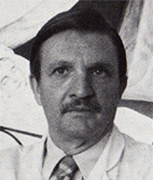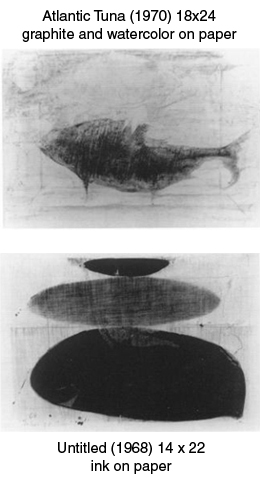


Metamorphosis/Transformation
Many artists, even over a lifetime, work in one characteristic style. Not Sublett. These two drawings can serve as a guide to Sublett’s artmaking approach. They offer a clue to understanding his great range in style, content, and form that otherwise might appear bewildering. While on the surface these drawings appear dissimilar, they do share similarities. The drawing on the right, Atlantic Tuna, 1970, depicts a realistic image of a fish in a glass case with other fishes in the background as if displayed in a museum. The other drawing, Untitled, 1968, presents us with a flat composition of three stacked abstract oval shapes. Stylistically and in terms of content and message, they are quite different. But in terms of shapes (repeated fish and fish-like shape), there is a kinship both visually and symbolically.
In reviewing his oeuvre, Sublett can be seen working from the observed and real and from abstract derivations from the real. His thinking allows him to flow back and forth from the real and abstract without boundaries. This constant metamorphosis produces his wide range of styles. In some ways, it reminds one of the digital ‘morphing’ seen in recent science fiction movies where familiar images are transformed. His mind and eye give freedom to his brush to explore whatever approach may be needed to fulfill the purpose at hand. His ability to see reality many ways, each equally “truthful”, has given the body of his work astonishing variety. It challenges us to journey with him on his perceptual odyssey.
A Mountain of Art
Carl Sublett is an incredibly prolific artist. In his 87 years he has worked virtually all day, every day, of his professional career creating thousands of paintings and drawings. Sublett’s work falls into two broad subject categories: his landscapes and his serial works. While often derived from landscape motifs, the serial works explore formal, aesthetic, and content issues beyond purely descriptive realism.
In the Marks Series and Rhythm Series begun in the late 70’s and early 80’s, there appears to be a synthesis of abstraction, suggested imagery, and gestural mark-making. In a formal sense, these series combine many of the pictorial “truths” discovered in earlier series. Each stroke is measured, controlled, and placed in precise, layered patterns so that the overall embracing shapes and gestural marks are in dynamic balance. As in music, the multi-direction strokes resemble rhythmic patterns or beats, while the melody of shapes frame and give unity to his visual “song”. Echoes of vaguely suggested images tie the composition to its particular thematic subject. These series are especially clear examples of Sublett’s interest in creating visual “energy” through pulsing strokes.
Landscape as a Metaphor
In the 80’s and 90’s, while continuing to pursue many of the previous series, Sublett began to develop his Travelogue, Window, and Social Calendar Series. The Travelogue and Window Series reaffirm his interest in more descriptive landscapes. This time; however, with a new emphasis on image used as iconic or symbolic metaphor. The Travelogue Series visits archetypal subjects reminiscent of picture postcards. He compresses images of rivers, bridges, animals, buildings, and landscapes into a montage-like compendium of remembered afterimages. The objects are treated more as pictographic symbols than as realistic images. His Window Series has much of the symbolic approach of the Travelogue Series. He reintroduces the framing device of bands on the left and right or the top and bottom that are common to many of his earlier landscapes and abstractions. But now, these works appear specifically as window frames, giving the impression that the observer is inside viewing the outside landscape. This distances us from reality and reinforces our
sense of a symbolic rather than a realistic presence in the observed scene. Both these series show some influence from the growing trend in the 80’s and 90’s toward Pop and Conceptual Art and the return of imagery as an iconic vehicle for social commentary. The Window and Travelogue Series are primarily conceptual in nature, springing from ideas about places rather than naturalistic depictions of places.
Sublett developed his Social Calendar Series in the late 80’s and early 90’s. It is his most singularly different series because it deals not with landscape, objects, or art making concerns, but with contemporary social and political issues. Drawing from his responses to the news of the day and its omnipresence in print and television, he creates a visual commentary concerning those issues that especially provoke him. The impact of mass communication and international coverage and its excess of “spin” or pre-digested interpretation of events, provides his grist. Paintings in this series are developed by assembling images that convey his ideas rather than rendering an observed scene. Once again, this is a conceptual process rather than a visually perceptual one. Like Goya and Daumier in the past, and such artists as Leon Golub, Barbara Kruger and Sue Coe at present, Sublett makes critical social commentary his subject.
Into The New Millennium
Sublett’s watercolors in the 90’s and into the new millennium return to familiar landscape subjects: coastal scenes, landmark structures, and Smoky Mountain landscapes. However, he revisits these themes with a new feeling and mood. Paintings such as Park Bridge, 1998 and Beach Rock, 2000 show a marked preference for softer edges and forms, vaporous atmosphere and a color palette emphasizing veils of rose-brown, soft pinks and blues. These characteristics create a dream-like diaphanous atmosphere that suggests a nostalgic reverie. They conjure a scene sensed deep in one’s memory rather than seen in cold reality. In this current direction, his years of looking, feeling, thinking and creating have been distilled and internalized to produce an essence of landscape. They are his visual ode and poetry to landscape mellowed by time, intimacy and love for the world about him.
The Inner and Outer Odyssey
“The true value of a man’s art, I believe, does not depend upon the capacity with which it is received by others, but the degree of personal conviction exercised in a lifetime of creating it. Because I believe no statement is too small to make, when I have something to say I put it down immediately and try not to concern myself with the dimension of the outcome. No matter how ambitious the effort, no painting is ever more than a fragment of the whole, If I look for too much, I may lose all.” Carl Sublett, 1980.
Sublett fills sketchbook after sketchbook with hundreds of ideas exploring everything that his mind and eye find arresting. The Social Calendar Series is only one example of the breadth of his responsiveness to the totality of the world around him. He is a perceptive and thoughtful voyager through life, He moves freely from things seen outwardly to things conceived conceptually and inwardly, all within the flow and context of his own inventive idioms. Viewing his life’s work in panorama, one is struck by its diversity on one hand, and its logical continuity on the other. His art is a rich visual travelogue seen through his eye, mind, and spirit. It is both an outer journey to places real and seen, and an inner journey shaped by his sensitive and perceptive insights. Viewed as a whole, it is a consummately beautiful odyssey. His life and work are the true sum of the man. In the end, they are one and the same.
Dr. Donald Kurka is a painter/photographer who served as Head of the Department of Art at the University of Tennessee from 1977 to 1992.